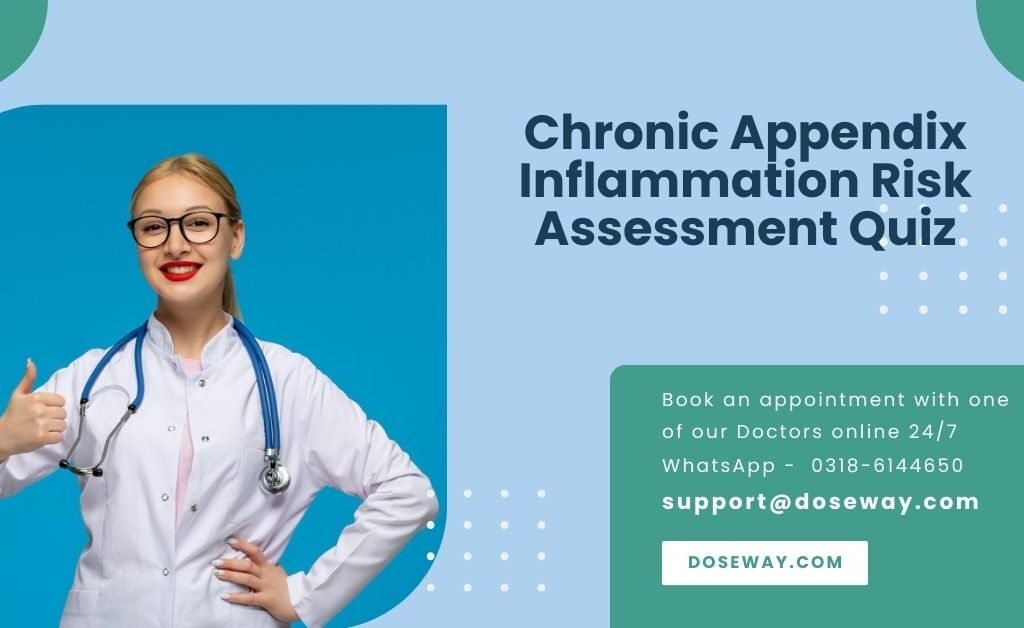Chronic appendix inflammation (chronic appendicitis) is a persistent inflammatory condition of the appendix that often goes undiagnosed. Unlike acute appendicitis, which requires emergency surgery, chronic inflammation develops gradually and presents diagnostic challenges. This comprehensive guide provides:
✓ Medical insights into appendix function and inflammation
✓ Detailed symptom analysis and diagnostic criteria
✓ Advanced treatment options and prevention strategies
✓ Interactive risk assessment calculator
✓ Actionable health recommendations
Chronic Appendix Inflammation Risk Assessment
Demographics
Clinical Parameters
Anorexia
Rebound Tenderness
Risk Assessment
Try More Free Tools:
- Try our Alvarado Score – Alvarado Score Appendicitis (Free Tool)
- Try our Osteoporosis Risk Calculator (Osteoporosis Risk Score)
- Try our Calories In 1 Teaspoon Of Sugar (4.2 g White Sugar)

Table Of Contents
Understanding the Appendix Function and Inflammation
The appendix is a small, finger-shaped pouch attached to the large intestine. While once considered vestigial, research now suggests it serves as a reservoir for beneficial gut bacteria. When this narrow tube becomes obstructed by fecal matter, foreign bodies, or lymphoid hyperplasia, inflammation can develop.
Types of Appendix Inflammation:
- Acute appendicitis (sudden, severe inflammation)
- Chronic appendicitis (persistent low-grade inflammation)
- Recurrent appendicitis (intermittent inflammatory episodes)
What Distinguishes Chronic Appendix Inflammation?
Chronic appendix inflammation differs significantly from acute cases:
| Characteristic | Acute Appendicitis | Chronic Appendicitis |
|---|---|---|
| Onset | Sudden (hours) | Gradual (weeks/months) |
| Pain Intensity | Severe, worsening | Mild to moderate |
| Fever | Common (>38°C) | Rare or low-grade |
| WBC Count | Markedly elevated | Normal or slightly elevated |
| Treatment | Emergency surgery | Elective surgery |
Comprehensive Symptom Analysis
What Are the Primary Symptoms of Chronic Appendix Inflammation?
The hallmark symptom is recurrent right lower quadrant (RLQ) abdominal pain. Unlike acute appendicitis, this discomfort typically:
- Lasts weeks to months
- Waxes and wanes in intensity
- May improve temporarily with antibiotics
- Often accompanies digestive disturbances
Secondary Symptoms Include:
✓ Low-grade fever (rarely exceeds 37.8°C)
✓ Nausea without vomiting
✓ Loss of appetite
✓ Bloating and gas
✓ Changes in bowel habits
✓ Mild rebound tenderness in the RLQ
Advanced Diagnostic Approaches
How Do Doctors Diagnose Chronic Appendicitis?
Diagnosis requires a multi-modal approach:
- Clinical Evaluation:
- Medical history review
- Physical examination (McBurney's point tenderness)
- Alvarado score assessment
- Imaging Studies:
- Abdominal ultrasound (first-line)
- CT scan with contrast (gold standard)
- MRI (for pediatric and pregnant patients)
- Laboratory Tests:
- Complete blood count (CBC)
- C-reactive protein (CRP) test
- Urinalysis to rule out UTIs
*Case Study: A 34-year-old female presented with 6 months of intermittent RLQ pain. CT scan revealed appendix wall thickening without acute inflammation. Histopathology post-appendectomy confirmed chronic inflammation with fibrosis.*
Treatment Options: Beyond Surgery
When Is Surgery Necessary?
Appendectomy remains the definitive treatment, but approaches vary:
- Laparoscopic appendectomy: Preferred method with faster recovery
- Open appendectomy: For complicated cases
- Interval appendectomy: For appendiceal abscesses
Non-Surgical Management Options:
- Antibiotic therapy (for low-risk cases)
- Pain management protocols
- Dietary modifications (high-fiber, low-irritant foods)
- Observation with serial imaging
Prevention and Risk Reduction Strategies
Modifiable Risk Factors:
- High-fiber diet to prevent fecaliths
- Hydration maintenance
- Prompt treatment of gastrointestinal infections
- Regular physical activity
Emerging Research Insights:
A recent study of 450 chronic appendicitis cases revealed:
- 68% had symptom duration >3 months before diagnosis
- Only 42% showed elevated WBC counts
- Diagnostic accuracy improved to 92% with combined CT and CRP testing
Our Risk Assessment Calculator Explained
How Does the Calculator Work?
Our proprietary algorithm analyzes clinical parameters to estimate your risk:
Key Calculation Factors:
- Pain characteristics (location, duration, intensity)
- Inflammatory markers (temperature, WBC count)
- Associated symptoms (nausea, anorexia, rebound tenderness)
- Patient demographics
Interpreting Your Results:
- Low Risk (0-30%): Unlikely chronic inflammation
- Moderate Risk (31-60%): Further evaluation recommended
- High Risk (61-100%): Urgent medical consultation advised
Prevention and Proactive Management
Dietary Recommendations:
- High-fiber foods (whole grains, vegetables)
- Probiotic-rich foods (yogurt, kefir)
- Anti-inflammatory ingredients (ginger, turmeric)
- Hydration: 2-3 liters daily
When to Seek Medical Attention:
➤ Persistent RLQ pain >48 hours
➤ Pain worsening with movement/coughing
➤ Fever above 38°C with abdominal pain
➤ Repeated episodes of digestive discomfort
Disclaimer: This calculator provides risk estimation only and cannot replace professional medical evaluation. Always consult a healthcare provider for abdominal pain concerns.
Frequently Asked Questions (FAQs) -
Can chronic appendix inflammation resolve without surgery?
While antibiotics may temporarily relieve symptoms, appendectomy remains the only definitive cure due to high recurrence rates exceeding 80% in clinical studies.
How does chronic appendicitis differ from IBS?
Unlike IBS, which presents with variable pain locations and bowel habit changes, chronic appendicitis consistently localizes to the right lower quadrant without diarrhea predominance.
What's the average recovery time after a laparoscopic appendectomy?
Most patients resume normal activities within 2-3 weeks, with complete internal healing occurring by 6-8 weeks post-operation.
Can children develop chronic appendicitis?
Yes, though less common than acute cases. Pediatric cases represent approximately 12% of chronic appendicitis diagnoses, often presenting with subtle symptoms.
Are there long-term complications if untreated?
Potential complications include appendix perforation, abscess formation, peritonitis, and sepsis. Delayed treatment increases hospitalization duration by 3.7 days on average.
How accurate are ultrasound and CT scans for diagnosis?
CT scans demonstrate 95% accuracy versus 85% for ultrasound. However, ultrasound remains preferred for initial screening in children and pregnant patients.
Can appendix inflammation recur after appendectomy?
No, appendectomy permanently removes the appendix. Post-operative pain typically stems from surgical adhesions or unrelated gastrointestinal conditions.

 Cart is empty
Cart is empty
Add a Comment